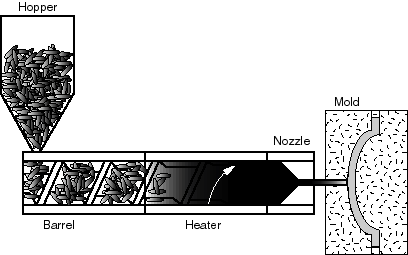Introduction to Injection Molding
Injection molding is considered one of the most common plastic part manufacturing processes. It can be used for producing parts from both thermoplastic and thermoset polymers. The process usually begins with taking the polymers in the form of pellets or granules and heating them to the molten state. The melt is then injected/forced into a chamber formed by a split-die mold. The melt remains in the mold and is either chilled down to solidify (thermoplastics) or heated up to cure (thermosets). The mold is then opened and the part is ejected.

A Typical Injection Molding Process
In spite of the relatively expensive tooling cost, injection molding remains the most popular manufacturing process for plastic materials in mass production, thanks to its low operational cost, high throughput, and the flexibility to make parts with complex shapes.
Polymers commonly used for injection molding include
◾Polystyrene (PS)
◾Acrylonitrile Butadiene Styrene (ABS)
◾Polyamide (PA)
◾Polypropylene (PP)
◾Polyethylene (PE)
◾Polyvinylchloride (PVC)
◾Other short fiber reinforced plastics
Injection Molding Design Guidelines
1.Use uniform wall thicknesses throughout the part. This will minimize sinking, warping, residual stresses, and improve mold fill and cycle times.
2.Use generous radius at all corners. The inside corner radius should be a minimum of one material thickness.
3.Use the least thickness compliant with the process, material, or product design requirements. Using the least wall thickness for the process ensures rapid cooling, short cycle times, and minimum shot weight. All these result in the least possible part cost.
4.Design parts to facilitate easy withdrawal from the mold by providing draft (taper) in the direction of mold opening or closing.
5.Use ribs or gussets to improve part stiffness in bending. This avoids the use of thick section to achieve the same, thereby saving on part weight, material costs, and cycle time costs.
Typical Complications of Injection Molding
◾Incomplete Fillings: ◦not enough resin to fill the mold completely
◦inadequate injection stroke
◦low injection rate
◦low injection pressure
◦resin viscosity too high
◦exotic geometry
◾Surface Imperfections: ◦moisture or air bubbles in the resin
◦temperature too high causing resin decomposition
◦not enough pressure to fill the mold completely
◦dirty mold
◾Burned Parts: ◦temperature too high
◦polymer trapped and degraded in the nozzle
◦slow chilling cycle
◾Warped Parts ◦uneven mold surface temperature
◦design flaws
◦parts removed from the mold too early
Pros and Cons of Injection Molding
Pros ◾Low costs in mass production
◾High precision
◾Complex parts. Geometries only limited by mold manufacturability.
Cons
◾High initial setup costs

